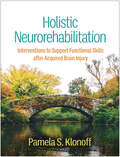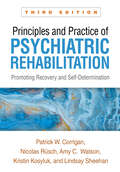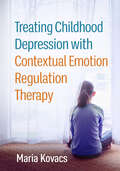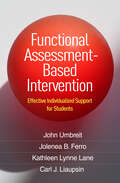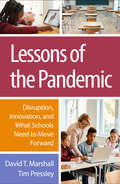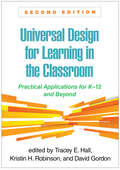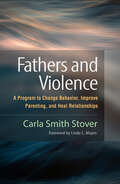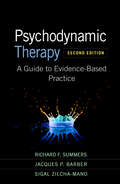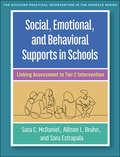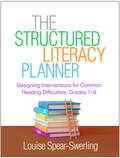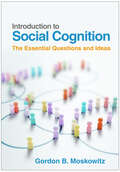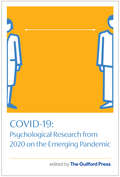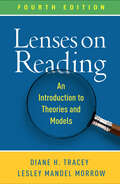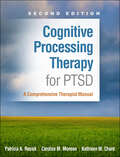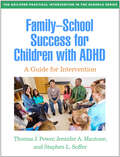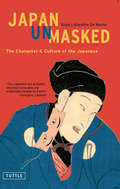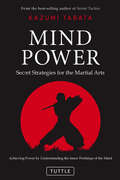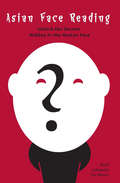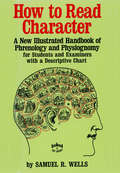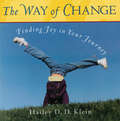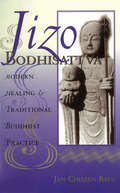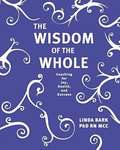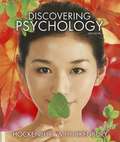- Table View
- List View
Holistic Neurorehabilitation: Interventions to Support Functional Skills after Acquired Brain Injury
by Pamela S. KlonoffHighly practical and comprehensive, this book provides a multimodal framework for helping patients with acquired brain injuries to identify and achieve meaningful functional goals in the home and community. In a convenient large-size format, the volume features rich case examples and interdisciplinary tools and strategies. Post-acute cognitive, physical, communication, emotional, vocational, interpersonal, family, and quality-of-life domains are all addressed, using state-of-the-art restorative and compensatory approaches. Coverage includes both individual and group therapies. Fifty reproducible forms and handouts can be photocopied from the book or downloaded from the companion website. The website also features a supplemental chapter on efficacy and outcomes research in neurorehabilitation, appendices with helpful resources, color versions of selected figures, and more.
Principles and Practice of Psychiatric Rehabilitation: Promoting Recovery and Self-Determination
by Patrick W. Corrigan Nicolas Rüsch Amy C. Watson Kristin Kosyluk Lindsay SheehanThe leading text and go-to practitioner resource on psychiatric rehabilitation is now in a thoroughly revised third edition, bringing readers up to date on current ideas, findings, and evidence-based best practices. The expert authors present the knowledge needed to help adults with psychiatric disabilities develop their strengths and achieve their life goals. The book describes effective ways to assess personal needs and aspirations; integrate medical and psychosocial interventions; implement supportive services in such areas as housing, employment, education, substance use, and physical health; and combat stigma and discrimination. "Personal Examples" throughout the text share the experiences of diverse individuals recovering from serious mental illness. New to This Edition *Increased attention to social determinants of health--for example, the impact of race, ethnicity, gender identity, sexual orientation, poverty, and criminal justice involvement. *Chapter on developing more equitable, culturally competent services. *Expanded coverage of physical health and wellness. *New and expanded discussions of community-based participatory research, peer recovery support providers, and other timely topics.
Treating Childhood Depression with Contextual Emotion Regulation Therapy
by Maria KovacsThis book is the authoritative presentation of contextual emotion regulation therapy (CERT), an innovative intervention expressly designed for depressed children ages 7–13 and their parents. CERT is grounded in decades of research on the development of emotion regulation and on "mood repair" difficulties as a risk factor for clinical depression. Step by step, Maria Kovacs describes ways to teach children skills to modulate feelings of sadness and distress and break the hold of depression symptoms. Extensive therapist, parent, and child exchanges illustrate key treatment principles. Clinicians learn how to structure CERT sessions and implement personalized social–interpersonal, cognitive, behavioral, problem-solving, and psychoeducational interventions. Reproducible tools in the appendices--including forms, posters, and a parent manual--can be downloaded and printed in a convenient 8 1/2" x 11" size.
Functional Assessment-Based Intervention: Effective Individualized Support for Students
by John Umbreit Jolenea B. Ferro Kathleen Lynne Lane Carl J. LiaupsinFrom noted authorities, this book presents a comprehensive approach to designing and implementing evidence-based Tier 3 behavior interventions for K–12 students. The authors' functional assessment-based intervention (FABI) process has been supported by multiple peer-reviewed studies conducted in authentic educational environments. Step by step, chapters spell out proven methods to define target behaviors, determine the function of the undesirable behavior, identify appropriate replacement behaviors, and deliver and monitor intensive interventions. Illustrated with real-world case examples, the book shows how to embed FABI within a school's integrated tiered system of supports. Guidance for scaling FABI district- and statewide is also provided. Ethical issues, professional standards, equity concerns, and cultural and linguistic considerations are addressed throughout. In a convenient large-size format, the book includes reproducible checklists and forms that can also be downloaded for ease of use.
Lessons of the Pandemic: Disruption, Innovation, and What Schools Need to Move Forward
by David T. Marshall Tim PressleyThe impacts of the COVID-19 pandemic on K–12 education have been pervasive and profound. This engaging book concisely outlines the current crisis in schools in the core areas of student learning, student and teacher mental health, and teacher burnout. Synthesizing original research, David T. Marshall and Tim Pressley offer in-depth descriptions of the disruptions caused by prolonged school closures and remote instruction. They also identify some positive changes, such as increased use of online resources and technology, flexible work models, and greater attention to social and emotional learning. Sharing key findings, concrete examples, and teachers&’ own voices about what they need to succeed, the book provides clear recommendations for moving schools forward effectively and sustainably.
Universal Design for Learning in the Classroom: Practical Applications for K-12 and Beyond
by Tracey E. Hall Kristin H. Robinson David GordonThe Universal Design for Learning (UDL) framework has grown from its origins in special education to being widely used to support all students, making the fully rewritten second edition of this indispensable guide more relevant than ever. Filled with practical, vivid examples and tips, the book demonstrates the power of UDL when applied to particular content areas. Specific teaching ideas are presented for literacy, STEM, project-based learning, career and technical education, and the arts. The editors and contributors describe practical ways to create thriving learning environments that use UDL to meet diverse learners' needs. New to This Edition *Entirely new content. *Coverage expanded from elementary and middle grades to secondary and beyond. *Innovative approaches embracing the growth of UDL and the ubiquity of digital technologies in today&’s classrooms. *Spotlight on issues of equity and inclusion. *Chapters on antiracism, social–emotional learning, career and technical education, journey mapping, and curriculum design. *Compelling discussions of advances in UDL principles and research directions.
Fathers and Violence: A Program to Change Behavior, Improve Parenting, and Heal Relationships
by Carla Smith StoverThis highly accessible book presents a new approach to treating men who use violence against their partners and/or children. The Fathers for Change (F4C) program has a unique focus on fostering fathers' accountability and reflective functioning, and repairing father–child relationships. Grounded in theory and research, it addresses a key need for parents who want to stay together or coparent successfully in the aftermath of violence, while prioritizing all family members' safety. Clinicians learn how to implement each component of F4C, from assessment to individual-focused work to coparent and family sessions, if appropriate. Illustrative case vignettes are featured throughout. An appendix provides 32 reproducible forms, worksheets, and handouts that can be downloaded (many in a fillable format) and printed as needed.
Psychodynamic Therapy: A Guide to Evidence-Based Practice
by Richard F. Summers Jacques P. Barber Sigal Zilcha-ManoFirmly grounded in contemporary clinical practice and research, this pragmatic guide for professionals and students is now in a revised and expanded second edition. The book explains the theory underlying psychodynamic approaches and lays out a model for understanding psychopathology. Vivid case examples demonstrate how to tailor psychodynamic therapy effectively for individual patients. The authors provide a framework for diagnosing the patient&’s core psychodynamic problem and engaging the most useful mechanisms of change, using an integrative approach. Special topics include remote and hybrid treatment, combining therapy with psychopharmacology, and working with couples and families. New to This Edition *Incorporates cutting-edge research on psychotherapy process and mechanisms of change. *Chapter on telepsychotherapy, including clear recommendations for practice. *More attention to the social determinants of health--the psychic effects of adversity and various forms of oppression. *New and revised case examples, with diversity in age, gender, race, culture, and sexual identity. See also Practicing Psychodynamic Therapy: A Casebook, edited by Summers and Barber, which features 12 in-depth cases that explicitly illustrate the approach in this book.
Social, Emotional, and Behavioral Supports in Schools: Linking Assessment to Tier 2 Intervention (The Guilford Practical Intervention in the Schools Series)
by Sara C. McDaniel Allison L. Bruhn Sara EstrapalaMeeting a critical need, this accessible guide addresses the "whats," "whys," and "how-tos" of developing and implementing effective Tier 2 social, emotional, and behavioral supports. The book provides explicit steps for identifying K–12 students who could benefit from Tier 2, matching evidence-based interventions to student needs, and making individualized, data-based decisions regarding adapting, fading, or intensifying supports. Chapters review exemplary interventions in the areas of conduct, self-regulation, social issues, emotional issues, and co-occurring academic and social–emotional–behavioral needs. The place of Tier 2 in schoolwide positive behavioral interventions and supports (PBIS) is explained, and keys to implementation fidelity are highlighted. In a large-size format for easy photocopying, the book includes 23 reproducible forms and checklists that can also be downloaded and printed. This book is in The Guilford Practical Intervention in the Schools Series, edited by Sandra M. Chafouleas.
The Structured Literacy Planner: Designing Interventions for Common Reading Difficulties, Grades 1-9
by Louise Spear-SwerlingStructured Literacy (SL) approaches are increasingly recognized as the gold standard for teaching struggling readers. This highly practical book walks educators through designing SL interventions for students with common types of reading difficulties--word reading, comprehension, or a combination of both. Louise Spear-Swerling offers tools for assessing students' reading profiles and tailoring SL to their needs. In a convenient large-size format, the volume is packed with case studies, sample lesson plans addressing both early and advanced stages of reading, instructional activities, and application exercises for teachers. A chapter on English language structure presents essential foundations for implementing SL effectively. The companion website features a knowledge survey about language structure (with answer key), as well as downloadable copies of the book's 14 reproducible forms. See also Louise Spear-Swerling's edited volume, Structured Literacy Interventions: Teaching Students with Reading Difficulties, Grades K–6, which surveys SL interventions across all components of literacy.
Introduction to Social Cognition: The Essential Questions and Ideas
by Gordon B. MoskowitzWhy are first impressions so powerful? How do we &“know&” what others are like when we cannot read their minds? How can scientists measure biases that people do not want to admit--or do not know they have? This engaging text delves into social cognition by exploring major questions in the field through an everyday lens. Students are introduced to core concepts and processes pertaining to how people come to know themselves and understand the behavior of others. Classic and contemporary findings and experimental methods are explained. The text connects the research to pressing contemporary problems--the roots of political polarization, why even rational people fall prey to misinformation, and the best ways to reduce prejudice. Boxed definitions of key terms are included throughout.
COVID-19: Psychological Research from 2020 on the Emerging Pandemic
by The Guilford PressThis book presents a range of research on COVID-19 and mental health from the earliest days of the pandemic. It features selected 2020 articles from the Journal of Social and Clinical Psychology and Psychodynamic Psychiatry. The book explores how the pandemic affected mental health providers, their practices, and their patients. Topics include: *The effects of social distancing on social engagement. *Coping with the pandemic among people with depression and anxiety. *Whether political orientations align with coping mechanisms. *Social media use and loneliness among young adults. *How service delivery and clinical training were challenged by--and responded to--the unfolding crisis. Whether addressing the isolation of those early days or the realities of providing much-needed psychiatric care, this book highlights key findings and research directions that continue to shape our thinking about the pandemic today.
Lenses on Reading: An Introduction to Theories and Models
by Diane H. Tracey Lesley Mandel MorrowNow in a revised and updated fourth edition incorporating current advances in research and instructional practices, this well-established text accessibly introduces prominent theories and models related to reading. The book is organized chronologically, from classical approaches to contemporary cognitive, social learning, physiological, and affective perspectives. It emphasizes that the more lenses educators possess for examining reading processes, the better equipped they will be to understand and facilitate children's literacy development. Pedagogical features include framing and discussion questions, learning activities, teacher anecdotes, and examples of how each model is applied in classroom practice and research. New to This Edition *Chapter on digital literacy. *Expanded discussions of direct/explicit instruction, social and emotional learning, critical literacy theory, critical race theory, culturally responsive teaching, social equity and justice, the science of reading, and neuroscientific lenses. *All chapters updated with the latest research; many new classroom anecdotes added. *Links to recommended YouTube videos illustrating the theories and models.
Cognitive Processing Therapy for PTSD: A Comprehensive Therapist Manual
by Patricia A. Resick Candice M. Monson Kathleen M. ChardThe authoritative presentation of cognitive processing therapy (CPT) for posttraumatic stress disorder (PTSD) is now in a revised and updated second edition, with an easier-to-use format and a new chapter on conceptualizing treatment. From CPT's developers, the manual includes session-by-session implementation guidelines and extensive sample dialogues. Shaded index tabs in the margins help clinicians quickly navigate to each session. The authors explain the theoretical and empirical underpinnings of CPT and discuss ways to work effectively with specific populations, such as combat veterans, sexual assault survivors, and culturally diverse and LGBTQIA+ clients. Forty-eight reproducible handouts can be photocopied from the large-size book or downloaded from the companion webpage. New to This Edition *Each session now has its own chapter, printed with shaded tabs for easy reference. *Reflects a wealth of new treatment research, conceptual refinements, and feedback from trainings of thousands of clinicians. *Chapter on cognitive case conceptualization. *Discusses additional treatment variations (telehealth, intensive CPT) and client populations (first responders). CPT is endorsed as a best practice for the treatment of PTSD by the U.S. Departments of Veterans Affairs and Defense, the International Society for Traumatic Stress Studies, and the U.K. National Institute for Health and Care Excellence (NICE). See also Getting Unstuck from PTSD, by Patricia A. Resick, Shannon Wiltsey Stirman, and Stefanie T. LoSavio, which presents CPT in a guided self-help format for trauma survivors.
Family-School Success for Children with ADHD: A Guide for Intervention (The Guilford Practical Intervention in the Schools Series)
by Thomas J. Power Jennifer A. Mautone Stephen L. SofferDistilling decades of research, this practical manual presents an innovative intervention for families of 6- to 10-year-olds (grades 1–5) with attention-deficit/hyperactivity disorder (ADHD). Family–School Success (FSS) focuses on improving children's behavior and academic performance by strengthening parent–child, teacher–student, and family–school relationships. Detailed guidelines are provided for implementing FSS with parent groups or individual families, including how to involve children in groups and collaborate with teachers. The authors discuss ways to deliver FSS effectively in school- and clinic-based settings, private practice, and primary care. In a convenient large-size format, the book features dozens of reproducible parent handouts and worksheets, assessment tools, and fidelity checklists, which can also be downloaded and printed. This book is in The Guilford Practical Intervention in the Schools Series, edited by Sandra M. Chafouleas.
Japan Unmasked: The Character & Culture of the Japanese (Tuttle Classics)
by Boye Lafayette De MenteThe growing globalization of world business, culture and communication--and Japan's increasingly important role as a leader in that world--makes understanding Japanese culture critical for business people, diplomats, students, educators and anyone else with an interest in Japan.<P><P>Westerners have recognized--and analyzed--the many unique aspects of Japanese culture since they first set foot in Japan in the 16th century. The special talents (and weaknesses) that characterize the Japanese way of life are by now well-documented. But few Westerners really understand the beliefs and values that underlie how the Japanese think and act, how and why these attributes have been preserved in Japanese culture from ancient times through the modern day, or the critical role they play in today's Japanese society.In Japan Unmasked veteran Japanologist and author Boye Lafayette De Mente explores the social, cultural, and psychological characteristics responsible for the unique nature of modern-day Japanese culture-- the real "face" behind the "mask"--and demonstrates how they have brought the Japanese to their central role on the world stage.
Mind Power
by Kazumi Tabata Kaiichi HasumiLife is full of adversities. There comes a time when education, social status, fame, fortune, and even family ties all become useless. At a decisive moment like this, the ability to focus one's entire being--to harness one's total spiritual and mental energy--is required for survival and success. In this book, Master Kazumi Tabata shares his knowledge in how to achieve this goal.When beginning any martial arts discipline, students study physical techniques. Only after much time and intense practice do these techniques become second nature. Yet there is a higher level where you feel at one with yourself, your opponent, and with the world around you . Your opponent moves in slow motion, whereas you move without thought, and you become unbeatable.In Mind Power: Secret Strategies for the Martial Arts, Kazumi Tabata, Grandmaster in the Shotokan and Shorinji styles of Karate, offers his personal teachings as to how martial arts students can reach the point where time seems to slow down, quick movements are seen in slow motion, and the full potential of one's inner power can be harnessed.Chapters Include:StrategyBasic Laws of the Body and MindStrategy of a Virtuous ManHow to Interpert Your Mind
Mind Power
by Kazumi Tabata Kaiichi HasumiAt the earliest stages of learning a martial art, students almost exclusively study the physical techniques. It is only after much time and intensive practice that these techniques become automatic. Reaching the point of ingrained movements is a major step in mastering a martial art. Yet when the practitioner learns to become one with himself, the opponent and with nature itself, when the opponent's moves appear as if in slow motion, the practitioner moves without thought and becomes unbeatable.In Mind Power, Master Kazumi Tabata, Grand Master in the Shotokan and Shorinji styles of Karate, offers his personal teachings as to how martial arts students can reach the point where time seems to slow down, quick movements are seen in slow motion, and the full potential of one's inner power can be harnessed.
Mind Power
by Kazumi Tabata Kaiichi HasumiAt the earliest stages of learning a martial art, students almost exclusively study the physical techniques. It is only after much time and intensive practice that these techniques become automatic. Reaching the point of ingrained movements is a major step in mastering a martial art. Yet when the practitioner learns to become one with himself, the opponent and with nature itself, when the opponent's moves appear as if in slow motion, the practitioner moves without thought and becomes unbeatable.In Mind Power, Master Kazumi Tabata, Grand Master in the Shotokan and Shorinji styles of Karate, offers his personal teachings as to how martial arts students can reach the point where time seems to slow down, quick movements are seen in slow motion, and the full potential of one's inner power can be harnessed.
Asian Face Reading
by Boye Lafayette De MenteImagine how much you could learn if you knew how to evaluate a person's character, health, fortune, social status, sexual charisma, and life expectancy from a careful reading of his or her face. <P><P> In China and Japan, face reading is a respectable analytical tool used to make business decisions, arrange marriages, and evaluate partnerships and friendships. Asian Face Reading offers a quick, practical, easy-to-understand and easy-to-apply introduction to the basic principles of face reading. The book is fully illustrated with dozens of examples readers can use to learn this increasingly popular practice-and to analyze their friends, colleagues, and loved ones.
How to Read Character
by Samuel R. WellsHere is a book with a lot of character-in fact, many characters, some famous and others infamous, from misers and murderers to presidents, philosophers and plenipotentiaries. These many and varied personalities are presented as illustrations of character traits.Certainly a new audience of readers will find many things in the book to enjoy and to ponder as well.
The Way of Change
by Hailey D. D. KleinHailey Klein's system for change is different from most of those based on visualisation because you don't begin with what you want: in order to access the energy around you, you begin with what is. Klein's simple three-step programme includes: Stage 1 - Separation/Awareness/Understanding; Stage 2 - Intention/Truth/Acceptance; Stage 3 - Action/Change/Momentum.
Jizo Bodhisattva
by Jan Chozen BaysJizo Bodhisattva is an important saint of the Mahayana Buddhist tradition, and is most prominent in Japanese Zen Buddhism. This book helps readers understand how this Buddhist saint of travellers, children and the dead can help people confront suffering. Accompanied with beautiful black and white photographs and illustrations, Bays writes for those who are grieving, those who have lost loved ones, or anyone with an interest in Buddhism or Zen.
The Wisdom of the Whole: Coaching for Joy, Health, and Success
by Linda Bark<p>Learn all about holistic/integral coaching! If you are a professional who helps others to lead flourishing, happier lives, this book will help you become even more effective. If you are interested in learning about effective change for yourself, this book is also for you because of its fun and easy design, playful illustrations, and interactive exercises. <p>The Wisdom of the Whole invites people to look through multiple windows for exploration and action. The powerful mental tools described in this book are based on critical thinking, analysis, and planning. But we can’t stop there! The stories clients tell themselves as well as techniques such as imagery and affirmations, can help clients travel forward on a path to their goals. Ways for coaches and clients to employ intuition and the more subtle aspects of being add to the complete approach. Finding out how sense of purpose can impact motivation or shape an aspiration is also part of this model described here. The multidimensional approach enables people to move more quickly and easily toward their goals with greater authenticity, often eliminating false starts or wrong turns.
Discovering Psychology 6th Edition
by Don Hockenbury Sandra E. HockenburyAn introductory Psychology text.
